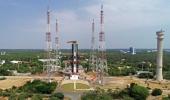The Visible Emission Line Coronagraph, the primary payload of Aditya L1 -- the first space based Indian mission to study the Sun, set for launch on Saturday -- will be sending 1,440 images per day to the ground station for analysis on reaching the intended orbit.

VELC, "the largest and technically most challenging" payload on Aditya-L1, was integrated, tested, and calibrated at the Indian Institute of Astrophysics's Centre for Research and Education in Science Technology campus in Hoskote near Bengaluru with substantial collaboration with ISRO.
Aditya-L1 will be launched by PSLV-C57 rocket on September 2 at 11:50 am. It carries seven payloads to study the Sun, four of which will observe the light from the Sun and the remaining three will measure insitu parameters of the plasma and magnetic fields.
Aditya-L1 will be placed in a halo orbit around the Lagrangian Point 1, which is 1.5 million km from the Earth in the direction of the Sun.
It will revolve around the Sun with the same relative position and hence can see the Sun continuously.
"From the continuum channel, which is the imaging channel, an image will come -- one image per minute. So approximately 1,440 images for 24 hours, we will be receiving at the ground station," Aditya L1 project scientist and operation manager for VELC Dr Muthu Priyal said.
She said, IIA will host the VELC payload operations centre, which will receive raw data from ISRO's Indian Space Science Data Centre, process them further to make it suitable for scientific analysis, and send it back to ISSDC for dissemination.
"Also a unique software has been developed by IIA to detect automatically the occurrence of coronal mass ejection and the time it happened, which will be provided to science community within 24 hours -- whether it is directed towards the earth or whether it is a very energetic event, if the speed is high, will it hit the earth or not, etc -- all those information will be made available," she added.
According to IIA officials, 190 kg VELC payload will send images for five years, which is the nominal life of the satellite, but it could last long depending on the fuel consumption, etc.
K Sasikumar Raja of IIA further said, out of four channels the continuum channel will run independently and send 1,440 images per day, while the other three spectroscopy channels will also give images, but that is dependent on how the observer wants.
The IIA scientists expect the first images to be available by February-end.
"The satellite is expected to be put into orbit in the middle of January and then we will do the test if all the systems are working properly and by the end of February we expect to get the regular data. It will take time and we have to test instrument by instrument. First we will test the smaller instruments, and the VELC's shutter will be opened last, by mid of February," Prof Jagdev Singh said.
Explaining the reason for opening the VELC's shutter last, S Nagabushana of IIA said, "we call it cross contamination. On reaching L1 orbit, the other payloads will be starting first, so that the outgassing coming from the other payloads, should not go and deposit on the primary mirror, which is very super polished and any deposition on the primary mirror will lead to scattering, which can mask the complete coronal mass, which is the field of interest."
VELC is an internally occulted coronagraph, with 40 different optical elements (mirrors, gratings, etc) inside it that are aligned precisely.
The atmosphere of the Sun, the corona, is what we see during a total solar eclipse. A coronagraph like the VELC is an instrument that cuts out the light from the disk of the Sun, and can thus image the much fainter corona at all times, IIA scientists said.
The main science drivers of Aditya-L1 are to understand the origin, dynamics, and propagation of coronal mass ejections and to help solve the coronal heating problem.
IIA's solar astronomy community is geared to calibrate and use data from VELC as well as other payloads on Aditya-L1 in the coming months to address fundamental questions about solar astrophysics as well as its impact on our daily lives.
VELC can capture images of the solar corona closer to the Sun's disc than any other solar space observatory.
This is because of the extremely accurately polished primary mirror, made by laboratory for electro optics systems of ISRO, which reduces light scatter inside VELC.
It can take an image of the corona with high spatial resolution and at an extremely rapid rate (about 3 times a second) in white light and in spectral lines. IIA built India's first large-scale “Class 10” Clean Room at MGK Menon Laboratory, CREST, for assembling VELC, IIA officials said.










